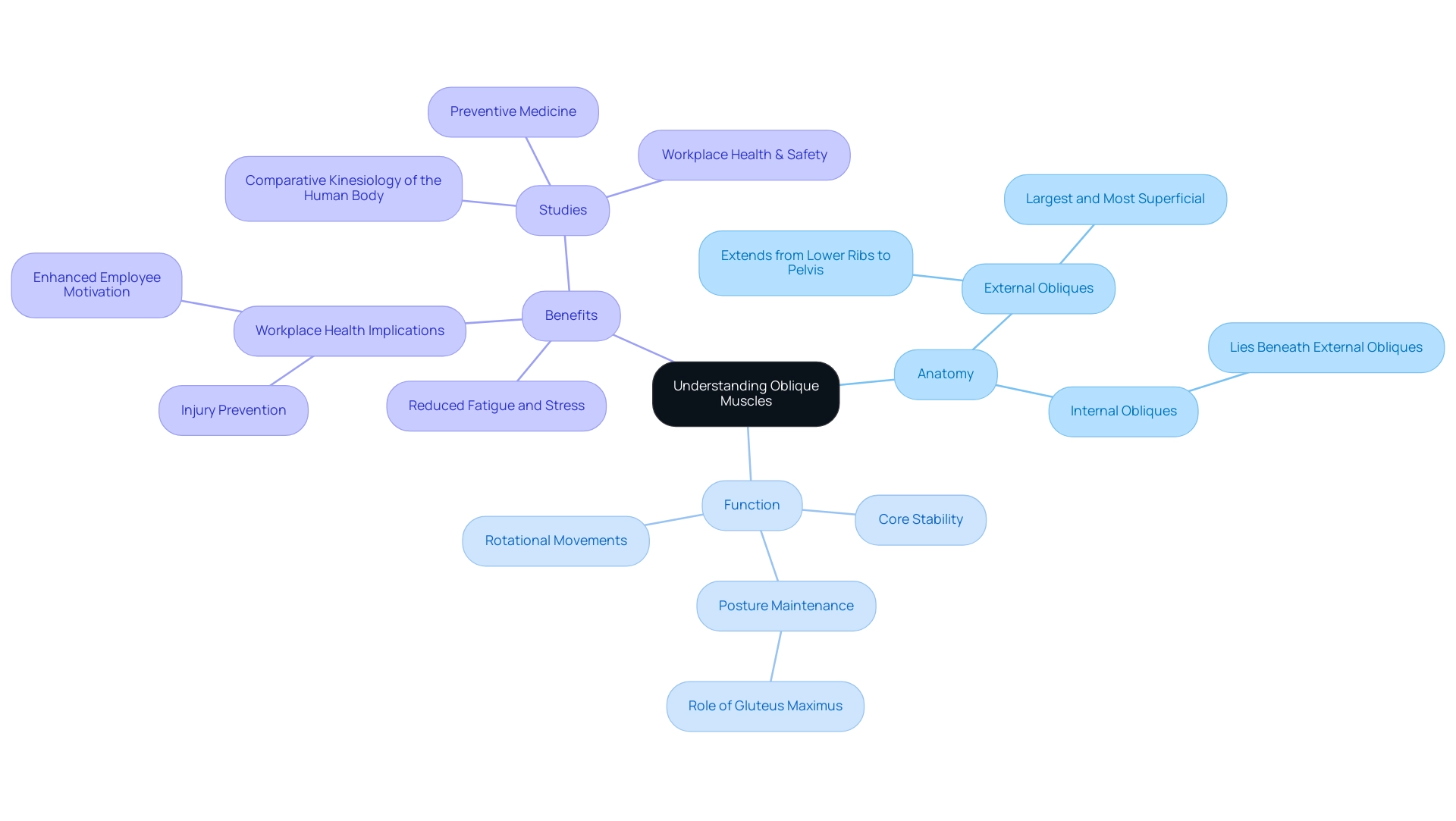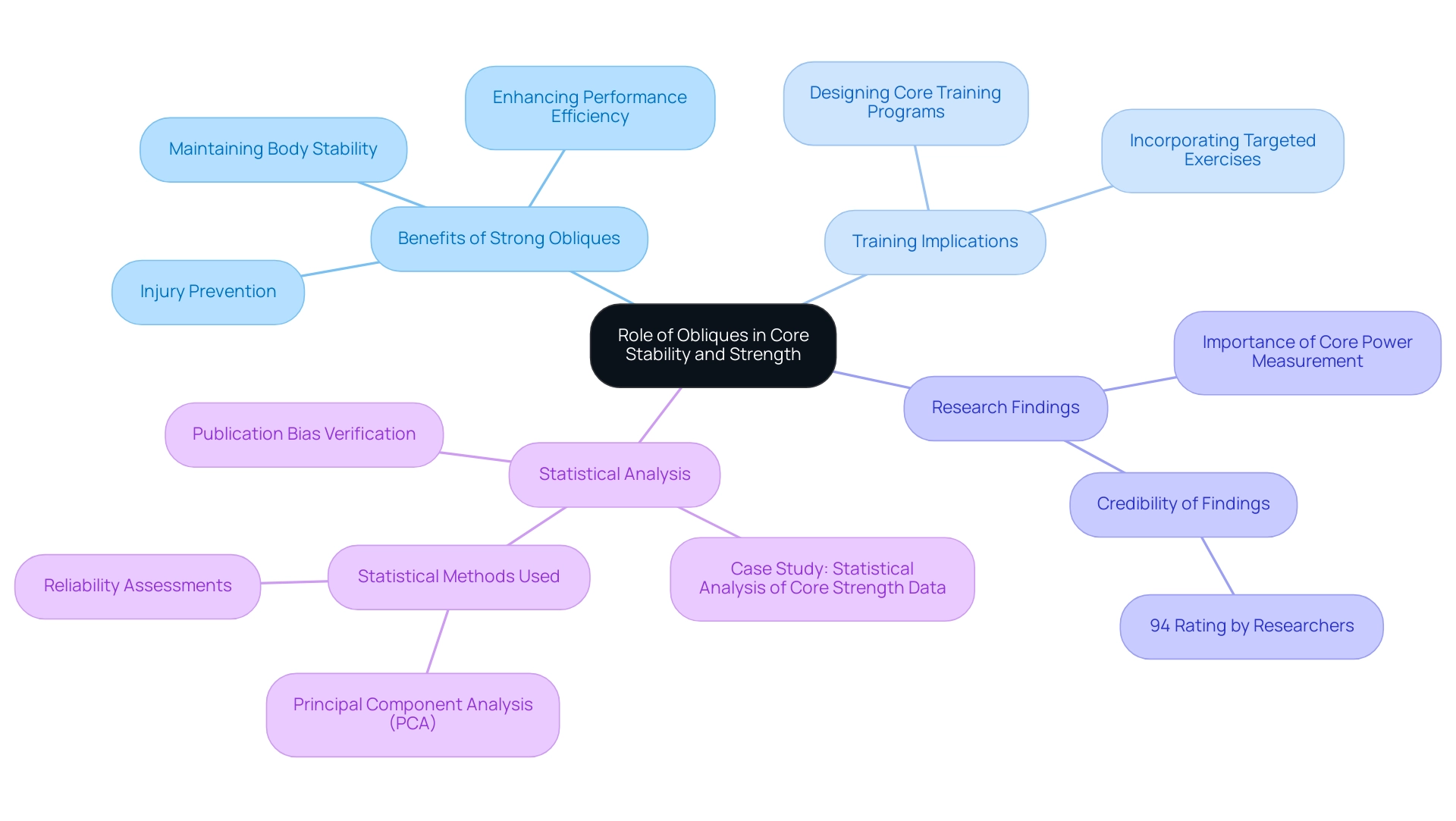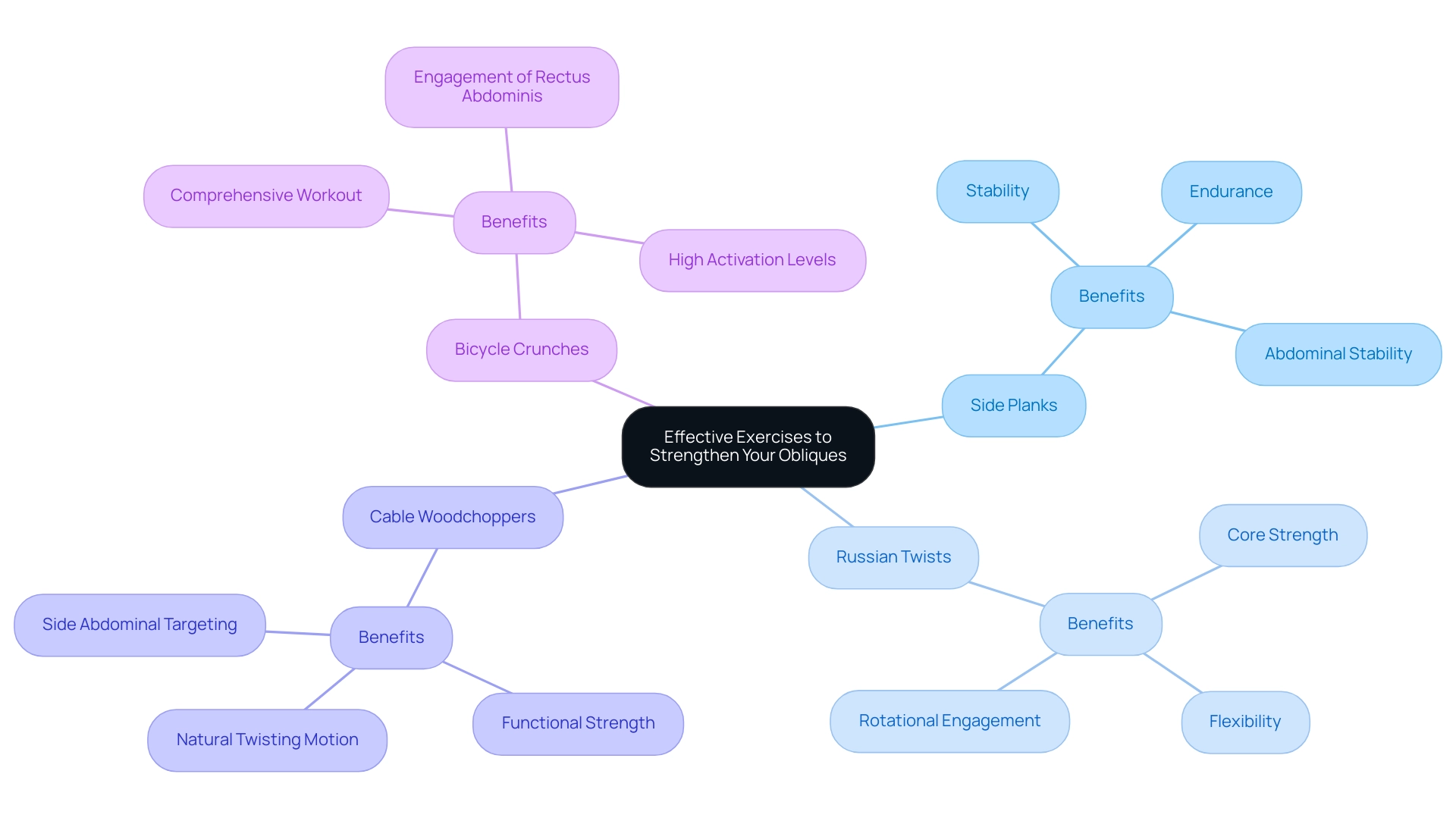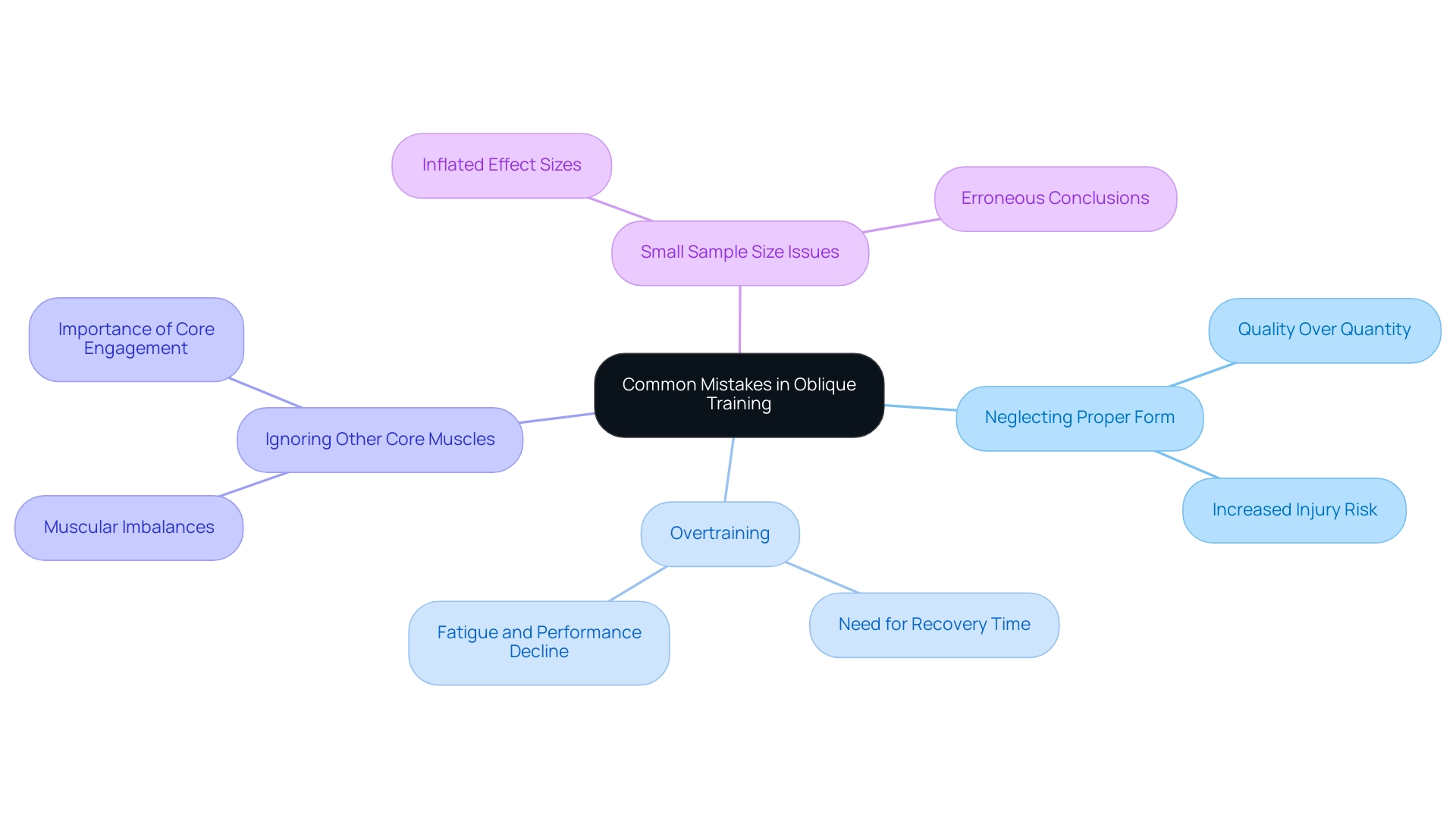Overview
The benefits of strong obliques are substantial, encompassing enhanced core stability, improved posture, and a reduced risk of injury—elements that are vital for both athletic performance and everyday activities. This article elucidates how strong obliques stabilize the spine, facilitate dynamic movements, and contribute to overall functional strength. These aspects underscore their critical role in injury prevention and physical well-being, making a compelling case for their inclusion in any wellness program.
Introduction
The oblique muscles, often overlooked in discussions about core strength, are essential players in maintaining a stable and functional body. Nestled along the sides of the abdomen, these muscles—both external and internal—are crucial for movements such as twisting and bending, contributing not only to athletic performance but also to everyday activities. As modern lifestyles increasingly promote sedentary behavior, the significance of strong obliques becomes even more pronounced, linking them to better posture and reduced back pain.
This article delves into the anatomy and function of the obliques, highlighting effective exercises to strengthen them while addressing common training mistakes. By understanding the vital role of these muscles, individuals can enhance their fitness regimens and overall well-being, paving the way for a healthier, more active life.
Understanding Oblique Muscles: Anatomy and Function
The slanted fibers, comprising both external and internal layers, are strategically positioned along the sides of the abdomen and are crucial for harnessing the advantages of robust obliques in various movements, including torso twisting and bending. The external obliques, being the largest and most superficial, extend from the lower ribs to the pelvis, while the internal obliques lie beneath them. Collectively, these tissues play a pivotal role in stabilizing the core and supporting the spine, particularly during rotational movements, thereby illustrating the benefits of strong obliques.
Their proper function is not merely vital for athletic performance; it is essential for maintaining good posture and preventing injuries, underscoring the benefits of strong obliques, especially in workplace environments where prolonged sitting and repetitive movements can exacerbate these issues. A recent chapter in 'Comparative Kinesiology of the Human Body' emphasizes the benefits of strong obliques in stabilizing the lumbar region, essential for regulating spinal movements and addressing posture-related challenges. Various studies, including those published in 'Preventive Medicine' and 'Workplace Health & Safety,' highlight the benefits of strong obliques in minimizing fatigue and stress, demonstrating a correlation between consistent physical activity and enhanced employee motivation at work.
These studies suggest that employees who engage in regular physical activity, particularly exercises that emphasize the benefits of strong obliques, report higher levels of motivation and lower absenteeism and presenteeism. The anterior transposition method, which restricts upward gaze to 30° to 35°, underscores the movement restrictions associated with stability, further highlighting the benefits of strong obliques. Moreover, the gluteus maximus plays a crucial role in maintaining upright posture and pelvic stability, illustrating the interrelation of body function.
By understanding these dynamics, HR benefits managers can better design workplace wellness programs that not only focus on injury prevention and stability but also enhance employee motivation and emotional well-being.

The Role of Obliques in Core Stability and Strength
The benefits of strong obliques are crucial, playing a pivotal role in maintaining body stability and serving as essential stabilizers during dynamic movements. Their function is critical in preserving the proper alignment of the spine and pelvis, which is vital for achieving balance and coordination. Notably, strong obliques help prevent excessive lateral flexion and rotation, significantly lowering the risk of injuries during various physical activities.
A stable foundation enhances performance efficiency, whether in lifting objects at work or in competitive sports. Recent findings emphasize the necessity of measuring essential power alongside maximal strength and endurance for a holistic assessment of athletic capabilities. As Kuan Dong from the Graduate School of Physical Education at Myongji University states, "These results suggest that it is necessary to adequately design fundamental training programs to improve sport-specific athletic performance."
Furthermore, 94% of researchers rate our articles as excellent or good, underscoring the credibility of our findings. A case study titled 'Statistical Analysis of Strength Data' employs various statistical methods to analyze strength data, enhancing our understanding of the relationships and variability among different measurements of strength. Consequently, incorporating targeted angled strengthening exercises into a comprehensive fitness regimen is essential for enhancing overall core strength and functionality, as well as realizing the benefits of strong obliques.

Key Benefits of Strengthening Your Obliques
Enhancing the side muscles yields numerous benefits, particularly strong obliques, with improved posture standing out as a primary advantage. Strong side muscles are vital in maintaining spinal alignment, significantly reducing back pain—a common issue linked to increasingly sedentary lifestyles. A recent analysis of 41 male participants, averaging 21.65 years in age, 178.98 cm in height, 77.10 kg in weight, and a BMI of 24.05 kg/m², indicates that effective core strengthening, including focused side training, correlates with measurable improvements in posture and a decrease in back pain incidents.
Morteza Homayounnia Firouzjah from the Department of Exercise Physiology emphasizes the importance of addressing postural abnormalities, stating,
Therefore, given the significance of these disorders in the spine and shoulder girdle, it is recommended that corrective motor specialists and therapists apply the exercise protocol of the present study to improve and correct the aforementioned postural abnormalities as well as scapular-humeral rhythm and motor performance.
This highlights the reliability of the outcomes measured in the cohort studies, which did not identify confounding factors. Additionally, the advantages of strong obliques extend to enhanced athletic performance; these strong side muscles contribute to improved balance, agility, and rotational power—essential components in various sports.
A robust core, encompassing the side muscles, illustrates the benefits of strong obliques by playing a crucial role in injury prevention, providing stability during dynamic movements, and alleviating strain on the lower back. The data analysis methods employed in the study, including linear regression, clustering analysis, and ANOVA, further substantiate the findings regarding the relationship between pelvic tilt and muscle activities. This comprehensive understanding emphasizes the necessity of integrating angled strengthening activities into regular training routines.

Effective Exercises to Strengthen Your Obliques
To attain optimal lateral strength, incorporating specific activities into a fitness routine is crucial. Among the most effective are:
- Side Planks: This exercise not only engages the internal and external obliques but also significantly enhances overall stability and endurance. Research indicates that side planks contribute positively to abdominal stability, showcasing the benefits of strong obliques, making them a staple in any oblique-strengthening routine.
- Russian Twists: By incorporating rotational movements, Russian twists effectively engage the side muscles, showcasing the benefits of strong obliques while promoting both core strength and flexibility. This dynamic activity has gained traction in recent fitness trends due to its versatility and effectiveness.
- Cable Woodchoppers: Mimicking the body's natural twisting motions, cable woodchoppers efficiently target the side abdominal muscles, showcasing the benefits of strong obliques while also fostering functional strength. This activity is particularly noted for its ability to simulate real-life movements, making it valuable for overall physical performance.
- Bicycle Crunches: This widely recognized movement combines flexion and rotation, highlighting the benefits of strong obliques by providing a comprehensive workout for the lateral abdominal muscles and also engaging the rectus abdominis. Significantly, data indicate that twisting leg raises are essential for side workouts, showing greater activation in comparison to conventional abdominal routines. In fact, the rectus abdominis and external muscles reached an activation higher than 60% of the maximal voluntary contraction in roll-out and bodysaw exercises. Additionally, researchers have noted that "the ab roller was no more effective than the traditional crunch, while the ab rocker was up to 80% less effective." Incorporating these movements into a consistent workout routine can lead to significant improvements in core strength and stability, demonstrating the benefits of strong obliques and underscoring the necessity of quantifying muscle contraction intensity for establishing effective training outcomes.

Common Mistakes to Avoid in Oblique Training
Training the side muscles effectively necessitates an awareness of several common pitfalls that can hinder progress and elevate the risk of injury. Neglecting proper form is a frequent mistake; prioritizing the quantity of repetitions over the quality of movement diminishes workout effectiveness and increases the likelihood of injuries.
As fitness expert Jeremy Ethier emphasizes, we can train and develop the side muscles most effectively by ensuring two key elements in a workout: selecting exercises that incorporate all the essential functions of these muscles and aligning with the diagonal orientation of their fibers. Overtraining is another critical concern; like any muscle group, the sides require adequate recovery time. Overtraining can lead to fatigue, diminished performance, and potential injuries.
Moreover, ignoring other core muscles can result in muscular imbalances. Solely focusing on the side abdominal muscles undermines maximum stability and strength, making it essential to include activities that engage all core groups. The significance of involving the side core muscles is substantiated by data indicating that during plank exercises, activity is 34% for the lateral external abdominal and 26% for the rectus internal abdominal. This underscores the necessity for effective engagement of these muscles.
Additionally, a case study on small sample sizes in training revealed that a limited group of participants experienced inflated effect sizes and erroneous conclusions about their training effectiveness. This emphasizes the importance of proper training methods to avoid such pitfalls. By recognizing and addressing these common mistakes, individuals can significantly enhance their training regimen, maximizing the benefits of strong obliques and leading to improved performance and injury prevention.

Conclusion
Strengthening the oblique muscles is vital for achieving a stable and functional core, which plays an essential role in both athletic performance and daily activities. The anatomy and function of these muscles reveal their importance in maintaining spinal alignment and preventing injuries. Incorporating exercises like:
- Side planks
- Russian twists
- Cable woodchoppers
can significantly enhance oblique strength, leading to improved posture, reduced back pain, and better overall physical performance.
Furthermore, common training mistakes such as:
- Neglecting proper form
- Overtraining
- Ignoring other core muscles
can hinder progress and increase the risk of injury. Awareness of these pitfalls is crucial for anyone looking to optimize their oblique training regimen.
Ultimately, understanding the significance of the obliques and committing to a balanced training program can pave the way for a healthier lifestyle. By prioritizing oblique strength, individuals not only enhance their fitness levels but also contribute to better posture, lower back health, and overall well-being, fostering a more active and resilient life.
Frequently Asked Questions
What are the main functions of the oblique muscles?
The oblique muscles play a crucial role in stabilizing the core, supporting the spine, and facilitating movements such as torso twisting and bending. They help maintain proper alignment of the spine and pelvis, which is vital for balance and coordination.
How do strong obliques contribute to injury prevention?
Strong obliques help prevent excessive lateral flexion and rotation, significantly lowering the risk of injuries during various physical activities. Their proper function is essential for maintaining good posture and preventing injuries, especially in environments where prolonged sitting and repetitive movements are common.
What benefits do strong obliques provide in the workplace?
Strong obliques are associated with minimizing fatigue and stress, enhancing employee motivation, and reducing absenteeism and presenteeism. Employees who engage in regular physical activity that strengthens the obliques report higher levels of motivation.
What is the relationship between obliques and athletic performance?
A stable foundation provided by strong obliques enhances performance efficiency in both lifting objects and competitive sports. They are essential for regulating spinal movements and improving sport-specific athletic performance.
How can workplace wellness programs benefit from understanding oblique muscles?
HR benefits managers can design workplace wellness programs that focus on injury prevention, stability, and enhancing employee motivation and emotional well-being by incorporating exercises that strengthen the obliques.
What research supports the benefits of strong obliques?
Various studies, including those published in 'Preventive Medicine' and 'Workplace Health & Safety,' highlight the benefits of strong obliques in reducing fatigue and stress and demonstrate a correlation between physical activity and improved employee motivation.

